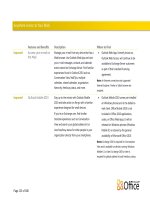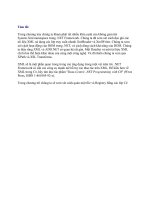Tài liệu Logic Synthesis With Verilog HDL part 5 pptx
Bạn đang xem bản rút gọn của tài liệu. Xem và tải ngay bản đầy đủ của tài liệu tại đây (32.69 KB, 10 trang )
[ Team LiB ]
14.7 Example of Sequential Circuit Synthesis
In Section 14.4.2
, An Example of RTL-to-Gates, we synthesized a combinational circuit.
Let us now consider an example of sequential circuit synthesis. Specifically, we will
design finite state machines.
14.7.1 Design Specification
A simple digital circuit is to be designed for the coin acceptor of an electronic newspaper
vending machine.
•
Assume that the newspaper cost 15 cents. (Wow! Who gives that kind of a price
any more? Well, let us assume that it is a special student edition!!)
•
The coin acceptor takes only nickels and dimes.
•
Exact change must be provided. The acceptor does not return extra money.
•
Valid combinations including order of coins are one nickel and one dime, three
nickels, or one dime and one nickel. Two dimes are valid, but the acceptor does
not return money.
This digital circuit can be designed by using the finite state machine approach.
14.7.2 Circuit Requirements
We must set some requirements for the digital circuit.
•
When each coin is inserted, a 2-bit signal coin[1:0] is sent to the digital circuit.
The signal is asserted at the next negative edge of a global clock signal and stays
up for exactly 1 clock cycle.
•
The output of the digital circuit is a single bit. Each time the total amount inserted
is 15 cents or more, an output signal newspaper goes high for exactly one clock
cycle and the vending machine door is released.
•
A reset signal can be used to reset the finite state machine. We assume
synchronous reset.
14.7.3 Finite State Machine (FSM)
We can represent the functionality of the digital circuit with a finite state machine.
•
input: 2-bit, coin[1:0]—no coin x0= 2'b00, nickel x5 = 2'b01, dime x10 = 2'b10.
•
output: 1-bit, newspaper—release door when newspaper = 1'b1
•
states: 4 states—s0 = 0 cents; s5 = 5 cents; s10 = 10 cents; s15 = 15 cents
The bubble diagram for the finite state machine is shown in Figure 14-10. Each arc in the
FSM is labeled with a label <input>/<output> where input is 2-bit and output is 1-
bit. For
example, x5/0 means transition to the state pointed to by the arc, when input is x5
(2'b01), and set the output to 0.
Figure 14-10. Finite State Machine for Newspaper Vending Machine
14.7.4 Verilog Description
The Verilog RTL description for the finite state machine is shown in Example 14-6
.
Example 14-6 RTL Description for Newspaper Vending Machine FSM
//Design the newspaper vending machine coin acceptor
//using a FSM approach
module vend( coin, clock, reset, newspaper);
//Input output port declarations
input [1:0] coin;
input clock;
input reset;
output newspaper;
wire newspaper;
//internal FSM state declarations
wire [1:0] NEXT_STATE;
reg [1:0] PRES_STATE;
//state encodings
parameter s0 = 2'b00;
parameter s5 = 2'b01;
parameter s10 = 2'b10;
parameter s15 = 2'b11;
//Combinational logic
function [2:0] fsm;
input [1:0] fsm_coin;
input [1:0] fsm_PRES_STATE;
reg fsm_newspaper;
reg [1:0] fsm_NEXT_STATE;
begin
case (fsm_PRES_STATE)
s0: //state = s0
begin
if (fsm_coin == 2'b10)
begin
fsm_newspaper = 1'b0;
fsm_NEXT_STATE = s10;
end
else if (fsm_coin == 2'b01)
begin
fsm_newspaper = 1'b0;
fsm_NEXT_STATE = s5;
end
else
begin
fsm_newspaper = 1'b0;
fsm_NEXT_STATE = s0;
end
end
s5: //state = s5
begin
if (fsm_coin == 2'b10)
begin
fsm_newspaper = 1'b0;
fsm_NEXT_STATE = s15;
end
else if (fsm_coin == 2'b01)
begin
fsm_newspaper = 1'b0;
fsm_NEXT_STATE = s10;
end
else
begin
fsm_newspaper = 1'b0;
fsm_NEXT_STATE = s5;
end
s10: //state = s10
begin
if (fsm_coin == 2'b10)
begin
fsm_newspaper = 1'b0;
fsm_NEXT_STATE = s15;
end
else if (fsm_coin == 2'b01)
begin
fsm_newspaper = 1'b0;
fsm_NEXT_STATE = s15;
end
else
begin
fsm_newspaper = 1'b0;
fsm_NEXT_STATE = s10;
end
end
s15: //state = s15
begin
fsm_newspaper = 1'b1;
fsm_NEXT_STATE = s0;
end
endcase
fsm = {fsm_newspaper, fsm_NEXT_STATE};
end
endfunction
//Reevaluate combinational logic each time a coin
//is put or the present state changes
assign {newspaper, NEXT_STATE} = fsm(coin, PRES_STATE);
//clock the state flip-flops.
//use synchronous reset
always @(posedge clock)
begin
if (reset == 1'b1)
PRES_STATE <= s0;
else
PRES_STATE <= NEXT_STATE;
end
endmodule
14.7.5 Technology Library
We defined abc_100 technology in Section 14.4.1
, RTL to Gates. We will use abc_100 as
the target technology library. abc_100 contains the following library cells:
//Library cells for abc_100 technology
VNAND//2-input nand gate
VAND//2-input and gate
VNOR//2-input nor gate
VOR//2-input or gate
VNOT//not gate
VBUF//buffer
NDFF//Negative edge triggered D flip-flop
PDFF//Positive edge triggered D flip-flop
14.7.6 Design Constraints
Timing critical is the only design constraint we used in this design. Typically, design
constraints are more elaborate.
14.7.7 Logic Synthesis
We synthesize the RTL description by using the specified design constraints and
technology library and obtain the optimized gate-level netlist.
14.7.8 Optimized Gate-Level Netlist
We use logic synthesis to map the RTL description to the abc_100 technology. The
optimized gate-level netlist produced is shown in Example 14-7
.
Example 14-7 Optimized Gate-Level Netlist for Newspaper Vending Machine FSM
module vend ( coin, clock, reset, newspaper );
input [1:0] coin;









